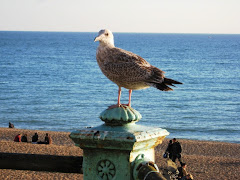It's interesting reading other people's reviews of restaurants. I confess that I always check out a restaurant on-line these days, before I visit it for the first time. I'm conscious that not all reviews (and not all reviewers) are fair and reliable, but you can generally cut through the bias and spot what might be a good or bad place, or a good place with an off night, or somewhere nice but beginning to take its customers for granted.
Of course, everyone is looking for different things when they go out. Me? I like places which are straightforward, and honest in what they do, whether it's a greasy-spoon cafe (not
too greasy, mind), an Indian or Italian, or a really upmarket joint that genuinely works hard excelling. I generally prefer places which aren't too expensive, too. (Apart from being lighter on the wallet, I often find they offer the best value - perfectly good food, decent service, and a bill that doesn't require a second mortgage.)
My worst experiences have generally been in places which are mid- to upper-range (for me, that's over £40 a head). Here, pretension often lurks behind fancy menus, and cooking that is not as good as it thinks it is. Throw in some slightly snotty or disorganised service (and 12.5% service charge automatically added) and a long wait for the bill, and you have my recipe for a ghastly night out.
Pubs with the '
gastro' label often seem to fall into this category, usually because of the service. If they're going to charge two people close to £100 for dinner, service had better be polite, efficient and friendly. Too often, it's just not.
Sadly, the UK is still one of the places where I'm most likely to feel like this. I've found the average standard of cooking in France still to be streets ahead (and, actually, this is where I think France really excels: forget Michelin stars, it is the average roadside restaurant). And I like the way I've been welcomed into a French family restaurant, even when arriving by motorcycle, in the rain. Rather than look at me as if I was about to murder them, they've made space, accommodated my damp leathers and dripping waterproofs, and then treated me just like anyone else, with decency. Isn't that what hospitality is supposed to be about?
At the other end of the spectrum, the bill may be mind boggling but I admit to having had some fantastic meals, with wine and service to match. 'Upstairs at the Savoy' in its old guise was a favorite for special occasions, and never ceased to impress, and I've had some excellent evenings at London's top hotels (OK, often with someone else paying).
My other half is even harder to please, maintaining - with some justification - that much of the food we've eaten out is not a great deal better than we could have rustled up ourselves at home (especially if one buys veg and other key
ingredients in a market where it is really fresh). I know that's not really the point, but it's a real downer to be
slightly disappointed with the food.
The most notable exception to all this - and it's a meal we still talk about, nearly 10 years later - was a restaurant called 'Seven Fish' in Key West, Florida. It was very strongly recommended to us, but without reservations it was a real trial to get a table. We nearly gave up (and, actually, organising their queue wasn't their high point) but we gave it ten more minutes, and then we were in.
The food was quite simply divine. Starters were perfect, the fish was simply astonishing - I recall having
Mahi Mahi baked with almonds, and for one of the few times in my life I was rendered completely speechless. But the coup
de grace was the dessert. We had been told that, whatever we ordered, we had to have the Chocolate Fudge Brownies, with real vanilla ice-cream.
Now, they're not something I'd normally go for, but I've still had them from time to time (being a
softy for fudge), and often found them rather disappointing. But this time,
both my partner and I were speechless. This wasn't just food that was better than sex, it knocked sex into a cocked hat (sorry...bad pun). I have still not tasted anything as memorable since, and I will never be able to cook something - anything - like that.
Interestingly, a range of food review sites splits even Seven Fish into two distinct categories: those awarding it 5/5 with hyperbole, and those awarding it 2/5, being summed up by 'we were disappointed...' The average is somewhere close to 5/5, so the former are in the majority. But it goes to show: we are all looking for something different, and maybe even the best slips up? Who knows.
Enjoy your meal.













